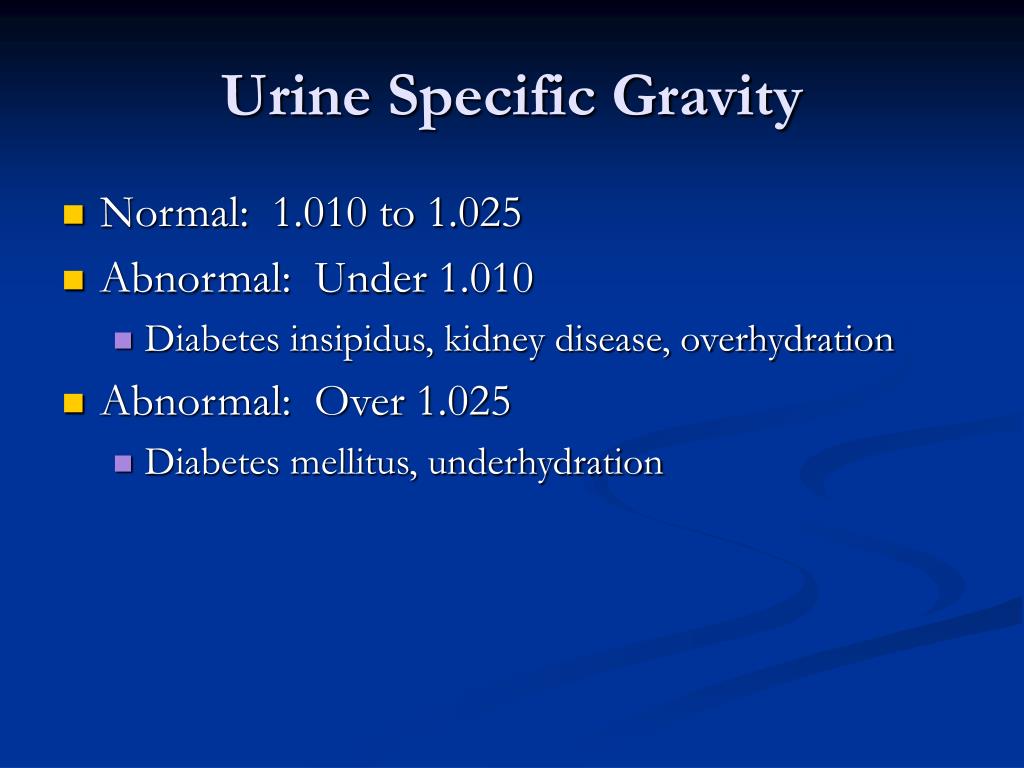

The refractometer should be temperature compensated for accurate and consistent estimates of USG. USG is estimated by refractometry (refraction of light in solution is affected by the number and size of the particles in the solution). USG estimated by dipstrip pads is not accurate over a wide range of USG and should not be used. (2)ġ000 mg/dL protein increases the USG approximately 0.003. (1)ġ000 mg/dL glucose increases the USG approximately 0.004. Urine specific gravity provides the most meaningful information about renal function on the urinalysis. A USG without knowledge of these aspects is meaningless and collection of urine and serum at the same time is essential. Sample for Collection (Type of Specimen, Color Tube) and Any Special Specimen Handling Notesįirst urine sample voided (or collected via catheterization) before fluid therapy or immediately after institution of fluid treatment PearlsĪ wide range of USG can be found in clinically healthy or sick horses, and concurrent evaluation of hydration status, USG, and serum chemistry values are essential for proper interpretation. Ketones: Urine with a positive ketone reading (rare in horses) has an overestimated USG. Protein: Urine with a reagent strip reading of 1+ to 2+ protein has an overestimated USG. PH of urine: The reagent strip underestimates USG in alkaline urine. When using dipsticks to determine USG, the following will alter the reading: ○ Specific gravity test pads on reagent strips are unreliable in equine urine. Depressed)Ī refractometer should be used for USG measurements. Specimen and Processing Considerations Lab Artifacts that May Interfere with Readings of Levels of this Substance (and how-Artificially Elevated vs. Drug Effects on Levelsĭiuretics will cause the USG to decrease. Important Interspecies DifferencesĪdults have greater concentrating ability than neonates. Next Diagnostic Step to Consider if Levels LowĪssess hydration status and evaluate serum blood urea nitrogen (BUN), creatinine, phosphate, glucose, calcium, sodium, and potassium. Hyposthenuria or isosthenuria in the face of dehydration or azotemia supports a diagnosis of renal disease. Hyposthenuria (USG 75% nonfunctioning tubules or chronic renal failure), administration of diuretics (furosemide) and hypercalcemia. A monochromatic light is led to the drop and the specific gravity can be measured depending on the angle of refraction of the light.Marked hyposthenuria (USG 1.001–1.005) is rarely seen in horses however, causes include psychogenic polydipsia, pituitary tumors, and diabetes insipidus. Refractometer: Only a drop of urine is needed.With a calibrated scale the specific gravity can be read depending on how much the test tube float in the distilled water. Urinometer: A test tube is filled with 10 or 20 ml of urine and then is placed in distilled water at 68-72✯ (20-22ªC).

Specific gravity may be also measured at labs with other procedures. They comprise up to 10 or more different reagents or chemical pads to perform different urine tests at the same time. In laboratories, there are automated machines that perform the analysis very fast, but it is also possible to buy strips that let you analyze a urine sample at home. It reacts (change color) when it is dipped into the urine specimen. The dipstick may comprise a reagent or chemical pad. The urine gravity test is measured frequently using reagent strips or dipsticks. This sample will be sent to the lab for the analysis. The patient must collect a sample of the urine in a specific container using a special kit. This test is performed along with other urine tests in what is called a urinalysis.


 0 kommentar(er)
0 kommentar(er)
